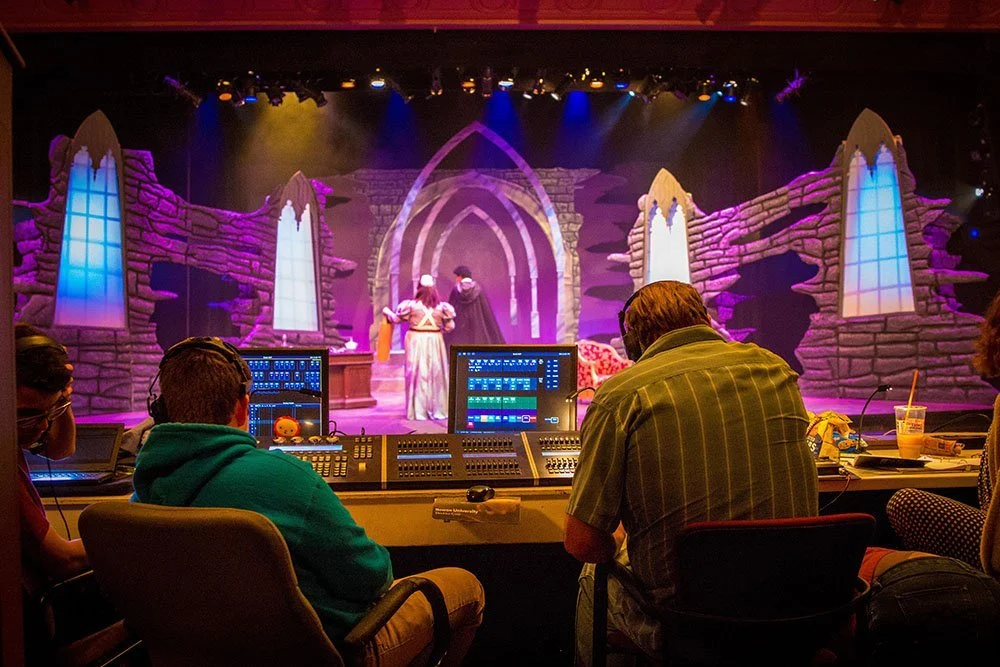Theatre Designers: What would productions be without them?
Rowan University
by Kaho Koda, Guest Editorial
Often, the first thing that the audience sees is the set lit up for pre-show, along with the carefully selected music. The play has not started, but here, the audience is already taking a peek into the world of the play.
As an audience member, I like observing how the stage is set up. Where are the props placed for the top of the show? Is the stage lit (or not lit)? That chair is in an awkward spot… I wonder why that is? And as the story unfolds, I witness the characters live in this meticulously crafted world.
“Oh, that’s how they use that door.”
“This tune creates such a bittersweet ambiance for this scene.”
“That costume is beautiful and elaborate, but also looks easy to move around in.”
Designers deserve so much more respect. They are responsible for creating the world of the play from scratch. What you see on stage is the result of their artistic senses combined with the director’s vision and interpretation of the play.
The talented actor delivers a strong monologue. Add music there. Add a spotlight and gobo there. Direct the actor to hold an object that symbolizes the theme of the play…
How do the designers set the tone of a specific scene on a limited budget and within the confines of the given space? So little, and yet so so much. It’s challenging and yet brilliant when all of the components come together in harmony. I believe that creativity soars when limitations are in place. In a production meeting one day, the director I was working with said,
“I just wish we could hang a car upside down. We can’t, right?”
Oh, the looks he received from all of the designers… He knew it was impossible for this production, but he still dreamed about the upside-down car above the stage. The set designer asked why he wanted the upside-down car. We listened as the designer asked questions about his intention, how it ties into his vision, the message he wanted to convey, and the details of what the car should look like. After she listened to his explanation in its entirety, she said,
“So we can’t rig an entire car upside down with our budget and resources. But from what you describe, I’m thinking... what if we have different car parts scattered across the set? I know local car repair shops in my neighborhood. We can try to reach out and see if we can rent some parts.”
And here it is. A designer actualizing a director’s seemingly unrealistic vision into something achievable. The number of times I’ve witnessed a designer suggesting a feasible alternative within the budget. Now that’s a superpower!
As an actor, why not take this immaculate and beautifully thought-out world and use it, play in it? Sometimes, an actor merely exists in their given space. He or she looks out of place in this supposed home of theirs. (Did this character just move into his ‘childhood home’?) It’s quite disappointing to see a well-constructed world go to waste.
No doubt, the magic of theatre works when every element comes together. A childhood bedroom with an intention to evoke nostalgia is useless if the actor makes no effort to connect with the space.
Have a conversation with the director about why the stage is set up in this specific way. Dissect the world that your character lives in.
Let’s say the stack of books on your character’s desk symbolizes his pretentious personality. He could be using the books to shield his true self and want to appear as an intellectual. Knowing that, wouldn’t you, as an actor, handle the stack of books differently?
Ask questions: Why is this chair set up so far away from the rest of the furniture? The script says it’s evening, but the light is insanely bright for this scene - how come? What’s the music that plays during my monologue?
To all the designers: Thank you for crafting a beautiful space. You do such amazing work. What would we do without you?
